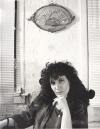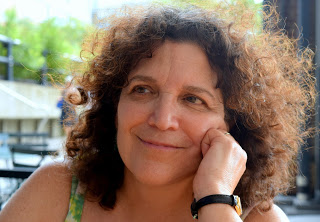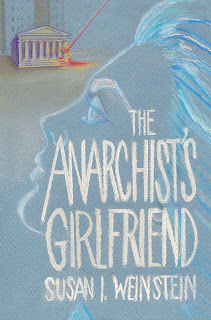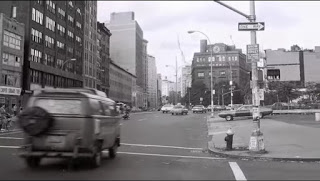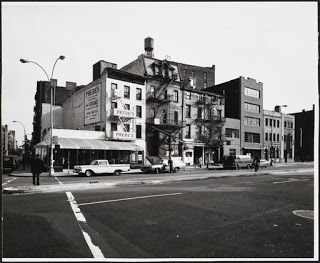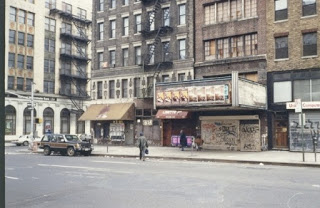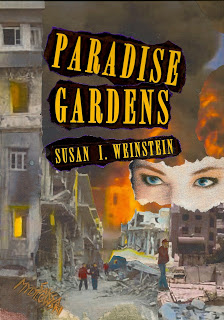Today’s author interview is with Susan Weinstein, whose underground classic, THE ANARCHIST’S GIRLFRIEND is being released in a definitive new edition from Pelekinesis. The wacky novel combines themes of terrorism, metaphysics and conspiracies and I gobbled it up.
Here is some background on Susan:
Susan I. Weinstein is a writer, playwright, and painter—and a graduate of Temple University's Tyler School of Art. She is married and lives in NYC. Susan has made her living publicizing books on arts, social and political issues, among other topics, for mainstream, small and university presses. Her review blog is
SARETT: I love writers who use comedy to address darker issues of identity and meaning — and you do this remarkably well in The Anarchist’s Girlfriend. What’s the biggest challenge in keeping it funny?
Weinstein: Keeping a perspective and not getting lost in the dark. I think humor is perspective. There’s a Moliere quote that’s stuck in my mind. It’s something like, if you look at life with your heart it’s a tragedy. If you look at it with your mind, it’s a comedy.
SARETT: Are there any writing rules that you secretly enjoy breaking?
Weinstein: Believability and likeability. I don’t think there’s a good writer who has those in mind or is sure what they mean, when they get down to work. Write what you know is another shibboleth. A person may understand what it’s like to live on Mars, without knowing how they know that. I think Ursula LeGuin has debunked quite a few rules.
SARETT: You’ve mentioned that Dostoyevsky's The Idiot prompted your invention of the other-worldly Anarchist’s Girlfriend. As I read, many of these characters seemed like people I’d met in downtown Manhattan. What was the mix of real vs. invented?
Weinstein: I lived in a Bowery loft down the street from Nan Goldin. One of her roommates, Jan, drew incredible comic strips and made clothes of the future. An Irish Anarchist silkscreened peace posters in a basement down the street. Mr. Dio was real, as was the Arizona Dust. I met him on a temp job. (He called me into his office to confess his fears that the dust used to store missiles would misfire.) The Llama is a composite with a good deal of Werner Erhard. Wes Mavine is based on an artist/businessman, whom I threw a broom at, after he fired me.
As for Sandy: I worked as a switchboard operator. My clients did include a church suicide prevention center, a prostitution ring, a dog grooming place. I once was crossing the street when a van stopped and the driver fell out in an epileptic fit. I directed traffic, as did the Anarchist's Girlfriend.
SARETT: You poke holes though pseudo-spiritualism, yet there's no doubt that the Anarchist's Girlfriend has psychic ability. Do you believe in such powers or is this a literary conceit?
Weinstein: Both. I believe some people have abilities we call psychic. I think they are often stronger in childhood and diminish. I think these abilities are based on science we don’t understand. The Maimonides Dream Institute in the late 1960’s proved the existence of dream telepathy—these experiments were published by Penguin. I read it because I experienced this as an adolescent. I dreamed a series of pop songs, before they came out!
SARETT: The wacky humor, and inventive plotting of the novel reminded me of Thomas Pynchon. Were you a fan of his? Other stylistic muses?
Weinstein: I read some Pynchon but I read all of John Dos Passos's USA Trilogy. The character, The Anarchist's Girlfriend, is a kind of blond descendent of Nana and Sister Carrie, though her soul's akin to Dostoyevsky's The Idiot. I like Bret Harte's Western humor in relating tragic events. Then there is science fiction: Philip K. Dick's Time Out of Joint and Theodore Sturgeon's IT.
SARETT: The novel is set in the New York of the early eighties, and yet it seems remarkably pertinent to our current obsessions with terrorism. If you were setting today, what changes (aside from sky high rents), would you envision for the story?
Weinstein: The New York of 2016 is far less idiosyncratic, more collective, hive-like than before. Today, every terrorist act seems calculated– most are players with a larger cultural agenda. Now I might show how cell phones and social media affect thinking. For instance, a desperate personal act like the Anarchist’s, would not be attempted in his insular way with no intention of hurting anyone. Similarly, Sandy’s operation would be a different grandiose project. She might be a career oriented performance artist—and the outcome of her operation would be subverted by her “contacts.” The Anarchist's Girlfriend might be a fashion muse, the Anarchist, a designer of brand logos, Wayne a news blogger.
SARETT: Your characters have such detailed, rich lives—it must have been difficult to let them go. Do you ever wonder about their fates? Did you contemplate a sequel?
Weinstein: I am attached to these characters. But they occupy a specific time and place. The Anarchist's Girlfriend's passage is from innocence to maturity. And all the characters experience a crucial passage. The ending shows the shape of some futures–Wayne's, the AG, The Anarchist, The Llama and Sandy. I can imagine them waking up in our time in the altered roles I described but no sequel.
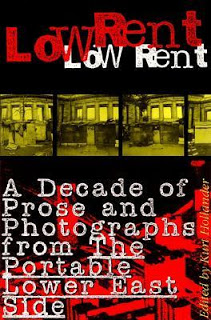 SARETT: This novel has an interesting publishing history–colorful in itself. Tell us a little about its evolution. Is the new version revised?
SARETT: This novel has an interesting publishing history–colorful in itself. Tell us a little about its evolution. Is the new version revised? Weinstein: I read and performed chapters of this novel in art bars/clubs and at marathon benefits for zines. It evolved slowly over several years. The introduction appeared in the 1984 debut issue of “The Portable Lower East Side,” now in NYU’s collection. The evolving MS attracted the notice of several notable editors, but was never picked up. Years later, I gave an editor my ONLY copy (by then on unplayable diskettes.) She loved it, but not for her press. Worse yet, she had trashed it (assuming no one was idiotic enough to send an original.) I got the box before the trash was picked up! 2000's, Eat Your Serial Press published it, but it was not a “professional” launch.
Now, finally, the book is getting a proper release with a small, literary press. The Pelekinesis book is a new edition—edited, with a new preface and visuals.
SARETT: I’m always seeking new (or forgotten) writers. Any books that you’d like recommend to our blog readers?
Weinstein:
Lawrence Ferlinghetti, Writing Across the Landscape
Konundrum: Selected Prose of Franz Kafka selected and translated by Peter Wortsman
Edith Nesbit: her books inspired Lewis' Narnia series and The Wizard of Oz books. Her fantasy is wise about innocence. The Story of The Story of the Amulet, 5 Children and IT, The Magic City
SARETT: What’s up next? Any projects in the works?
Weinstein: I am finishing new material for the 2017 New Editions: Paradise Gardens, which takes place in 2050 on the Earth's surface and 3011 underground; and Tales of The Mer Family Onyx: Mermaid Stories on Land and Under the Sea. I have a new novel based on blacked-out v-mail– plus a play to finish and marketing of another, “The Wapshot Whatever.”
Learn more about Susan:
Twitter @swpubrel
ORDER from Pelekenesis here



